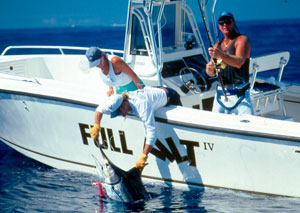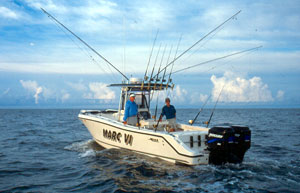A basic offshore trolling spread features individual baits or lures placed at varying distances behind the boat in a "W" or "V" pattern. There are numerous variations, of course, but rarely do pros fail to place at least one bait well behind the rest of the spread. This long bait is generally positioned 75 to 200 feet back, and is designed to fool fish that are leery of approaching the boat.

While long baits are nothing new, an increasing number of offshore anglers are discovering that setting a line much farther back than normal results in more fish, especially on tough days. How far back are we talking? Try 500 yards in some cases!
Going to Extremes
The "Way, Way Back," or WWB, is a tactic used by several Mid-Atlantic pros to catch more yellowfin and school bluefin tuna. It's seeing heavy play off northern North Carolina, Virginia and Maryland, and its popularity is rapidly expanding to other areas.
One practitioner is Captain Harvey Shiflet IV, who runs the 56-foot custom sportfisherman Outer Limits out of Oregon Inlet, North Carolina. Shiflet relies on the WWB to produce yellowfin tuna in May and June, when the local waters experience heavy fishing pressure. "We have a lot of rocks, drop-offs and ledges from the 500 to 700 line," says Shiflet. "When the fishing's good, we're likely to have at least 100 boats trolling the ledges. All those boats force the tuna down and it becomes difficult to catch them on baits set at traditional trolling distances."
Shiflet pays out 400 to 500 yards of 80-pound line from a pair of 50 Wide Internationals. That's approximately 3/4 of the reels line capacity! The lines are rigged with Sea Witch-skirted ballyhoos and fished from the outriggers. Sometimes Shiftlet will add a third WWB with a skirted ballyhoo fished from the bridge. "You can't see the baits," adds Shiflet. "They're too far back. But they're swimming in undisturbed water far behind the boat. And those baits catch fish when all else fails."
Long-Distance Ballys
Off Ocean City, Maryland, Captain Robby Paquette has considerable experience at catching tunas on the WWB. Paquette prefers to run skirted ballyhoo from the outriggers and a naked, chin-weighted ballyhoo from the bridge, all on 80-pound-class outfits. Approximately half the line capacity is paid out on all three reels. The bridge line is set farthest back, with the outrigger baits run within 25 to 50 yards of each other to help lessen the risk of a tangle during a turn.

"The WWBs produce 90 percent of the catch on our tuna trips," states Paquette. "They're deadly on school bluefins, and I've even taken bigeyes on them. I can't really explain why they're so effective, but it may be that they are being seen by tuna that are coming up again after being put down by the boat."
With up to 500 yards of line behind the boat, extra responsibility falls on the helmsman. The two biggest concerns, outside of being spooled by a fish, are tangles and cut-offs caused by other boats running over the line. Turns must be well planned and slowly executed, with the captain factoring in the course of other boats in the vicinity. Off Virginia and extreme North Carolina, many captains fish WWBs, and therefore give each other plenty of room to maneuver. However, these lines must sometimes be shortened in a hurry to compensate for other fishermen who don't know about the WWB. And I'm sure that the sight of two baits swimming along with no boat in close proximity has steered many astonished anglers away from their drink coolers!
Keep it Moving
Because of the extreme length of the WWB lines and the inherent stretch of monofilament, it's essential to keep the boat moving following a strike. Not only does this help set the hook, it may result in a second strike. After about 30 seconds, the throttles can be pulled back and the "lucky" angler can begin to crank in his fish.

"If a fish threatens to spool us, we'll start to make a gradual turn and give chase," says Paquette. "You have to know where your other WWB bait is to avoid running over it. It's sort of like white marlin fishing. We'll maintain trolling speed while chasing a hooked fish and keep a few baits out in hopes of getting another strike. Even after we've slowed the boat, we'll still keep a bait or two in the water, looking for a drift bite."
When trolling for tuna, both Paquette and Shiflet use straight 80-pound test with a 40- to 50-foot terminal section separated from the main line by a small wind-on swivel to prevent line twist. Both men also drop back their other baits when in the WWB mode. For example, Shiflet doubles the length of his regular lines. His flat lines are set approximately 50 feet back, with the short shotgun line (run from the fighting chair) positioned 60 feet back. The short outrigger baits are positioned 150 to 200 feet back, depending on sea conditions.
As for trolling speed, Robby Paquette feels that six knots is the magic number, although he points out that his skirted natural baits catch fish when trolled as slowly as four knots and as fast as eight knots. For those not into the natural-bait scene, artificial lures are also extremely productive when fished on the WWB.
The California WWB
David Brackmann of the Huntington Harbor and Cabo-based Caliente sport fishing boats has been using his version of the WWB to score more yellowfins off Southern California when the fish become associated with dolphins (the mammal kind) during late summer and fall. When he finds a school, he starts off by trolling a normal pattern of spreader bars and cedar plugs over the dolphins. In the process, he watches his fishfinder to determine the depth of the tuna. If he doesn't succeed in raising a fish on the bars and plugs, he switches to his version of the WWB.
After breaking out a set of 20- or 30-pound outfits rigged with 25-yard headers of 20-pound-test fluorocarbon and circle hooks, Brackmann tries to predict the dolphins route, then motors well ahead of the mammals and pitches out a series of surface and weighted lines baited with sardines. With the reels in free-spool, he continues moving ahead another 200 yards. Brackmann then drifts as the dolphins and tuna, undisturbed by the boat, swim through the sardine baits. To set the hook, the angler must reel in line as the tuna races off, pulling the circle hook into the corner of the fish's jaw.
Brackmann's tactic has proven itself on boat-shy and heavily fished yellowfins. He uses a similar approach in Cabo for intercepting schools of large yellowfins associated with dolphins. However, in this situation he drifts back goggle-eyes on 80-pound-class tackle rigged with 80- to 130-pound fluorocarbon leaders and circle hooks.

The WWB is a hot tactic that will only become hotter as more anglers give it a try. Just take it from Captain Harvey Shiflet IV, who offers this final bit of advice: "Whether you're fishing from a small boat or a big sportfisherman, start out with just one WWB to get a feel for it. And don't be afraid to drop it way, way back. That's what makes it work! On many a day, it has been the difference between catching fish and not catching fish aboard my boat."

